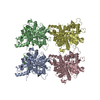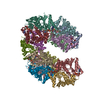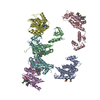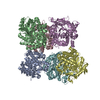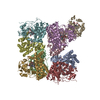+ データを開く
データを開く
- 基本情報
基本情報
| 登録情報 | データベース: EMDB / ID: EMD-5981 | |||||||||
|---|---|---|---|---|---|---|---|---|---|---|
| タイトル | Cryo-Electron Microscopy Reconstruction of Glucocorticoid Receptor-bound Hsp90-Hsp70-Hop Chaperone Complex | |||||||||
 マップデータ マップデータ | Reconstruction of client-bound Hsp90-Hsp70-Hop chaperone complex | |||||||||
 試料 試料 |
| |||||||||
 キーワード キーワード | Hsp90 / Hsp70 / Hop / Glucocorticoid Receptor | |||||||||
| 機能・相同性 |  機能・相同性情報 機能・相同性情報: / : / Regulation of NPAS4 gene transcription / regulation of glucocorticoid biosynthetic process / nuclear glucocorticoid receptor activity / cellular heat acclimation / steroid hormone binding / negative regulation of inclusion body assembly / C3HC4-type RING finger domain binding / glucocorticoid metabolic process ...: / : / Regulation of NPAS4 gene transcription / regulation of glucocorticoid biosynthetic process / nuclear glucocorticoid receptor activity / cellular heat acclimation / steroid hormone binding / negative regulation of inclusion body assembly / C3HC4-type RING finger domain binding / glucocorticoid metabolic process / response to cortisol / positive regulation of nucleotide-binding oligomerization domain containing 2 signaling pathway / PTK6 Expression / neuroinflammatory response / dynein axonemal particle / positive regulation of microtubule nucleation / mammary gland duct morphogenesis / ATP-dependent protein disaggregase activity / microglia differentiation / misfolded protein binding / maternal behavior / astrocyte differentiation / positive regulation of tumor necrosis factor-mediated signaling pathway / regulation of mitotic spindle assembly / cellular response to interleukin-7 / protein folding chaperone complex / RND1 GTPase cycle / aggresome / adrenal gland development / regulation of gluconeogenesis / cellular response to glucocorticoid stimulus / sperm mitochondrial sheath / sulfonylurea receptor binding / dATP binding / CTP binding / positive regulation of protein polymerization / Scavenging by Class F Receptors / vRNP Assembly / UTP binding / cellular response to steroid hormone stimulus / sperm plasma membrane / chaperone-mediated autophagy / Rho GDP-dissociation inhibitor binding / Respiratory syncytial virus genome replication / telomerase holoenzyme complex assembly / mitochondrial transport / Uptake and function of diphtheria toxin / Drug-mediated inhibition of ERBB2 signaling / Resistance of ERBB2 KD mutants to trastuzumab / Resistance of ERBB2 KD mutants to sapitinib / Resistance of ERBB2 KD mutants to tesevatinib / Resistance of ERBB2 KD mutants to neratinib / Resistance of ERBB2 KD mutants to osimertinib / Resistance of ERBB2 KD mutants to afatinib / Resistance of ERBB2 KD mutants to AEE788 / Resistance of ERBB2 KD mutants to lapatinib / Drug resistance in ERBB2 TMD/JMD mutants / protein import into mitochondrial matrix / TPR domain binding / dendritic growth cone / mRNA catabolic process / motor behavior / Assembly and release of respiratory syncytial virus (RSV) virions / PIWI-interacting RNA (piRNA) biogenesis / non-chaperonin molecular chaperone ATPase / : / Sema3A PAK dependent Axon repulsion / protein unfolding / regulation of protein ubiquitination / positive regulation of cell size / HSF1-dependent transactivation / Regulation of HSF1-mediated heat shock response / estrogen response element binding / cellular response to unfolded protein / response to unfolded protein / negative regulation of extrinsic apoptotic signaling pathway in absence of ligand / enzyme-substrate adaptor activity / cellular response to dexamethasone stimulus / HSF1 activation / skeletal muscle contraction / nuclear receptor-mediated steroid hormone signaling pathway / regulation of protein-containing complex assembly / FOXO-mediated transcription of oxidative stress, metabolic and neuronal genes / telomere maintenance via telomerase / Attenuation phase / chaperone-mediated protein complex assembly / regulation of postsynaptic membrane neurotransmitter receptor levels / cellular response to transforming growth factor beta stimulus / axonal growth cone / neurofibrillary tangle assembly / RHOBTB2 GTPase cycle / ATP metabolic process / core promoter sequence-specific DNA binding / positive regulation of lamellipodium assembly / vesicle-mediated transport / nitric oxide metabolic process / eNOS activation / Tetrahydrobiopterin (BH4) synthesis, recycling, salvage and regulation / DNA polymerase binding / inclusion body 類似検索 - 分子機能 | |||||||||
| 生物種 |  Homo sapiens (ヒト) Homo sapiens (ヒト) | |||||||||
| 手法 | 単粒子再構成法 / クライオ電子顕微鏡法 / 解像度: 38.0 Å | |||||||||
 データ登録者 データ登録者 | Kirschke E / Goswami D / Southworth DR / Griffin PR / Agard DA | |||||||||
 引用 引用 |  ジャーナル: Cell / 年: 2014 ジャーナル: Cell / 年: 2014タイトル: Glucocorticoid receptor function regulated by coordinated action of the Hsp90 and Hsp70 chaperone cycles. 著者: Elaine Kirschke / Devrishi Goswami / Daniel Southworth / Patrick R Griffin / David A Agard /  要旨: The glucocorticoid receptor (GR), like many signaling proteins, depends on the Hsp90 molecular chaperone for in vivo function. Although Hsp90 is required for ligand binding in vivo, purified apo GR ...The glucocorticoid receptor (GR), like many signaling proteins, depends on the Hsp90 molecular chaperone for in vivo function. Although Hsp90 is required for ligand binding in vivo, purified apo GR is capable of binding ligand with no enhancement from Hsp90. We reveal that Hsp70, known to facilitate client delivery to Hsp90, inactivates GR through partial unfolding, whereas Hsp90 reverses this inactivation. Full recovery of ligand binding requires ATP hydrolysis on Hsp90 and the Hop and p23 cochaperones. Surprisingly, Hsp90 ATP hydrolysis appears to regulate client transfer from Hsp70, likely through a coupling of the two chaperone's ATP cycles. Such coupling is embodied in contacts between Hsp90 and Hsp70 in the GR:Hsp70:Hsp90:Hop complex imaged by cryoelectron microscopy. Whereas GR released from Hsp70 is aggregation prone, release from Hsp90 protects GR from aggregation and enhances its ligand affinity. Together, this illustrates how coordinated chaperone interactions can enhance stability, function, and regulation. | |||||||||
| 履歴 |
|
- 構造の表示
構造の表示
| ムービー |
 ムービービューア ムービービューア |
|---|---|
| 構造ビューア | EMマップ:  SurfView SurfView Molmil Molmil Jmol/JSmol Jmol/JSmol |
- ダウンロードとリンク
ダウンロードとリンク
-EMDBアーカイブ
| マップデータ |  emd_5981.map.gz emd_5981.map.gz | 3.7 MB |  EMDBマップデータ形式 EMDBマップデータ形式 | |
|---|---|---|---|---|
| ヘッダ (付随情報) |  emd-5981-v30.xml emd-5981-v30.xml emd-5981.xml emd-5981.xml | 13.9 KB 13.9 KB | 表示 表示 |  EMDBヘッダ EMDBヘッダ |
| 画像 |  emd_5981.png emd_5981.png | 73.2 KB | ||
| アーカイブディレクトリ |  http://ftp.pdbj.org/pub/emdb/structures/EMD-5981 http://ftp.pdbj.org/pub/emdb/structures/EMD-5981 ftp://ftp.pdbj.org/pub/emdb/structures/EMD-5981 ftp://ftp.pdbj.org/pub/emdb/structures/EMD-5981 | HTTPS FTP |
-検証レポート
| 文書・要旨 |  emd_5981_validation.pdf.gz emd_5981_validation.pdf.gz | 78.4 KB | 表示 |  EMDB検証レポート EMDB検証レポート |
|---|---|---|---|---|
| 文書・詳細版 |  emd_5981_full_validation.pdf.gz emd_5981_full_validation.pdf.gz | 77.5 KB | 表示 | |
| XML形式データ |  emd_5981_validation.xml.gz emd_5981_validation.xml.gz | 494 B | 表示 | |
| アーカイブディレクトリ |  https://ftp.pdbj.org/pub/emdb/validation_reports/EMD-5981 https://ftp.pdbj.org/pub/emdb/validation_reports/EMD-5981 ftp://ftp.pdbj.org/pub/emdb/validation_reports/EMD-5981 ftp://ftp.pdbj.org/pub/emdb/validation_reports/EMD-5981 | HTTPS FTP |
-関連構造データ
- リンク
リンク
| EMDBのページ |  EMDB (EBI/PDBe) / EMDB (EBI/PDBe) /  EMDataResource EMDataResource |
|---|---|
| 「今月の分子」の関連する項目 |
- マップ
マップ
| ファイル |  ダウンロード / ファイル: emd_5981.map.gz / 形式: CCP4 / 大きさ: 6.4 MB / タイプ: IMAGE STORED AS FLOATING POINT NUMBER (4 BYTES) ダウンロード / ファイル: emd_5981.map.gz / 形式: CCP4 / 大きさ: 6.4 MB / タイプ: IMAGE STORED AS FLOATING POINT NUMBER (4 BYTES) | ||||||||||||||||||||||||||||||||||||||||||||||||||||||||||||||||||||
|---|---|---|---|---|---|---|---|---|---|---|---|---|---|---|---|---|---|---|---|---|---|---|---|---|---|---|---|---|---|---|---|---|---|---|---|---|---|---|---|---|---|---|---|---|---|---|---|---|---|---|---|---|---|---|---|---|---|---|---|---|---|---|---|---|---|---|---|---|---|
| 注釈 | Reconstruction of client-bound Hsp90-Hsp70-Hop chaperone complex | ||||||||||||||||||||||||||||||||||||||||||||||||||||||||||||||||||||
| ボクセルのサイズ | X=Y=Z: 2.4 Å | ||||||||||||||||||||||||||||||||||||||||||||||||||||||||||||||||||||
| 密度 |
| ||||||||||||||||||||||||||||||||||||||||||||||||||||||||||||||||||||
| 対称性 | 空間群: 1 | ||||||||||||||||||||||||||||||||||||||||||||||||||||||||||||||||||||
| 詳細 | EMDB XML:
CCP4マップ ヘッダ情報:
| ||||||||||||||||||||||||||||||||||||||||||||||||||||||||||||||||||||
-添付データ
- 試料の構成要素
試料の構成要素
-全体 : Human chaperones Hsp90 and Hsp70 bound with the human co-chaperon...
| 全体 | 名称: Human chaperones Hsp90 and Hsp70 bound with the human co-chaperone Hop and the ligand binding domain of the human glucocorticoid receptor N-terminally fused with the maltose binding protein |
|---|---|
| 要素 |
|
-超分子 #1000: Human chaperones Hsp90 and Hsp70 bound with the human co-chaperon...
| 超分子 | 名称: Human chaperones Hsp90 and Hsp70 bound with the human co-chaperone Hop and the ligand binding domain of the human glucocorticoid receptor N-terminally fused with the maltose binding protein タイプ: sample / ID: 1000 詳細: Complex was purified using size exclusion chromatography. 集合状態: One homodimer of Hsp90 bound to one Hsp70, one Hop, and one MBP-GRLBD Number unique components: 4 |
|---|---|
| 分子量 | 理論値: 380 KDa |
-分子 #1: Heat shock protein 90-alpha
| 分子 | 名称: Heat shock protein 90-alpha / タイプ: protein_or_peptide / ID: 1 / Name.synonym: Hsp90 / コピー数: 1 / 集合状態: Dimer / 組換発現: Yes |
|---|---|
| 由来(天然) | 生物種:  Homo sapiens (ヒト) / 別称: Human Homo sapiens (ヒト) / 別称: Human |
| 分子量 | 理論値: 84.66 KDa |
| 組換発現 | 生物種:  |
| 配列 | UniProtKB: Heat shock protein HSP 90-alpha / InterPro: Heat shock protein Hsp90 family |
-分子 #2: Heat shock 70 kDa protein
| 分子 | 名称: Heat shock 70 kDa protein / タイプ: protein_or_peptide / ID: 2 / Name.synonym: Hsp70 / コピー数: 1 / 集合状態: monomer / 組換発現: Yes |
|---|---|
| 由来(天然) | 生物種:  Homo sapiens (ヒト) / 別称: Human Homo sapiens (ヒト) / 別称: Human |
| 分子量 | 理論値: 70.052 KDa |
| 組換発現 | 生物種:  組換細胞: Sf9 |
| 配列 | UniProtKB: Heat shock 70 kDa protein 1B / InterPro: Heat shock protein 70 family |
-分子 #3: Glucocorticoid Receptor Ligand Binding Domain
| 分子 | 名称: Glucocorticoid Receptor Ligand Binding Domain / タイプ: protein_or_peptide / ID: 3 / Name.synonym: GRLBD 詳細: Maltose Binding Protein (MBP) tag attached to N-terminus コピー数: 1 / 集合状態: monomer / 組換発現: Yes |
|---|---|
| 由来(天然) | 生物種:  Homo sapiens (ヒト) / 別称: Human Homo sapiens (ヒト) / 別称: Human |
| 分子量 | 理論値: 74.926 KDa |
| 組換発現 | 生物種:  |
| 配列 | UniProtKB: Glucocorticoid receptor / InterPro: Glucocorticoid receptor |
-分子 #4: Stress-induced-phosphoprotein 1
| 分子 | 名称: Stress-induced-phosphoprotein 1 / タイプ: protein_or_peptide / ID: 4 / Name.synonym: Hop / コピー数: 1 / 集合状態: monomer / 組換発現: Yes |
|---|---|
| 由来(天然) | 生物種:  Homo sapiens (ヒト) / 別称: Human Homo sapiens (ヒト) / 別称: Human |
| 分子量 | 理論値: 62.639 KDa |
| 組換発現 | 生物種:  |
| 配列 | UniProtKB: Stress-induced-phosphoprotein 1 / InterPro: Heat shock chaperonin-binding |
-実験情報
-構造解析
| 手法 | クライオ電子顕微鏡法 |
|---|---|
 解析 解析 | 単粒子再構成法 |
| 試料の集合状態 | particle |
- 試料調製
試料調製
| 緩衝液 | pH: 7.5 詳細: 50 mM HEPES, 50 mM KCl, 2 mM DTT, 5 mM MgCl2, 0.2 mM ADP |
|---|---|
| グリッド | 詳細: C-flat holey carbon grid, 2 micron hole, 0.5 micron space |
| 凍結 | 凍結剤: ETHANE / チャンバー内湿度: 70 % / チャンバー内温度: 75 K / 装置: FEI VITROBOT MARK I / 手法: two one-second blots before plunging |
- 電子顕微鏡法
電子顕微鏡法
| 顕微鏡 | FEI TECNAI F20 |
|---|---|
| アライメント法 | Legacy - 非点収差: Astigmatism was corrected at 250,000 times magnification. |
| 日付 | 2011年9月21日 |
| 撮影 | カテゴリ: CCD フィルム・検出器のモデル: TVIPS TEMCAM-F816 (8k x 8k) 実像数: 214 / 平均電子線量: 30 e/Å2 |
| 電子線 | 加速電圧: 120 kV / 電子線源:  FIELD EMISSION GUN FIELD EMISSION GUN |
| 電子光学系 | 照射モード: FLOOD BEAM / 撮影モード: BRIGHT FIELD / Cs: 2.2 mm / 最大 デフォーカス(公称値): 4.0 µm / 最小 デフォーカス(公称値): 2.2 µm / 倍率(公称値): 60000 |
| 試料ステージ | 試料ホルダーモデル: OTHER |
| 実験機器 |  モデル: Tecnai F20 / 画像提供: FEI Company |
- 画像解析
画像解析
| 詳細 | The particles were manually selected. |
|---|---|
| CTF補正 | 詳細: CTF Find |
| 最終 再構成 | 解像度のタイプ: BY AUTHOR / 解像度: 38.0 Å / 解像度の算出法: OTHER / ソフトウェア - 名称: EMAN / 使用した粒子像数: 10149 |
| 最終 角度割当 | 詳細: EMAN: 15 |
 ムービー
ムービー コントローラー
コントローラー




